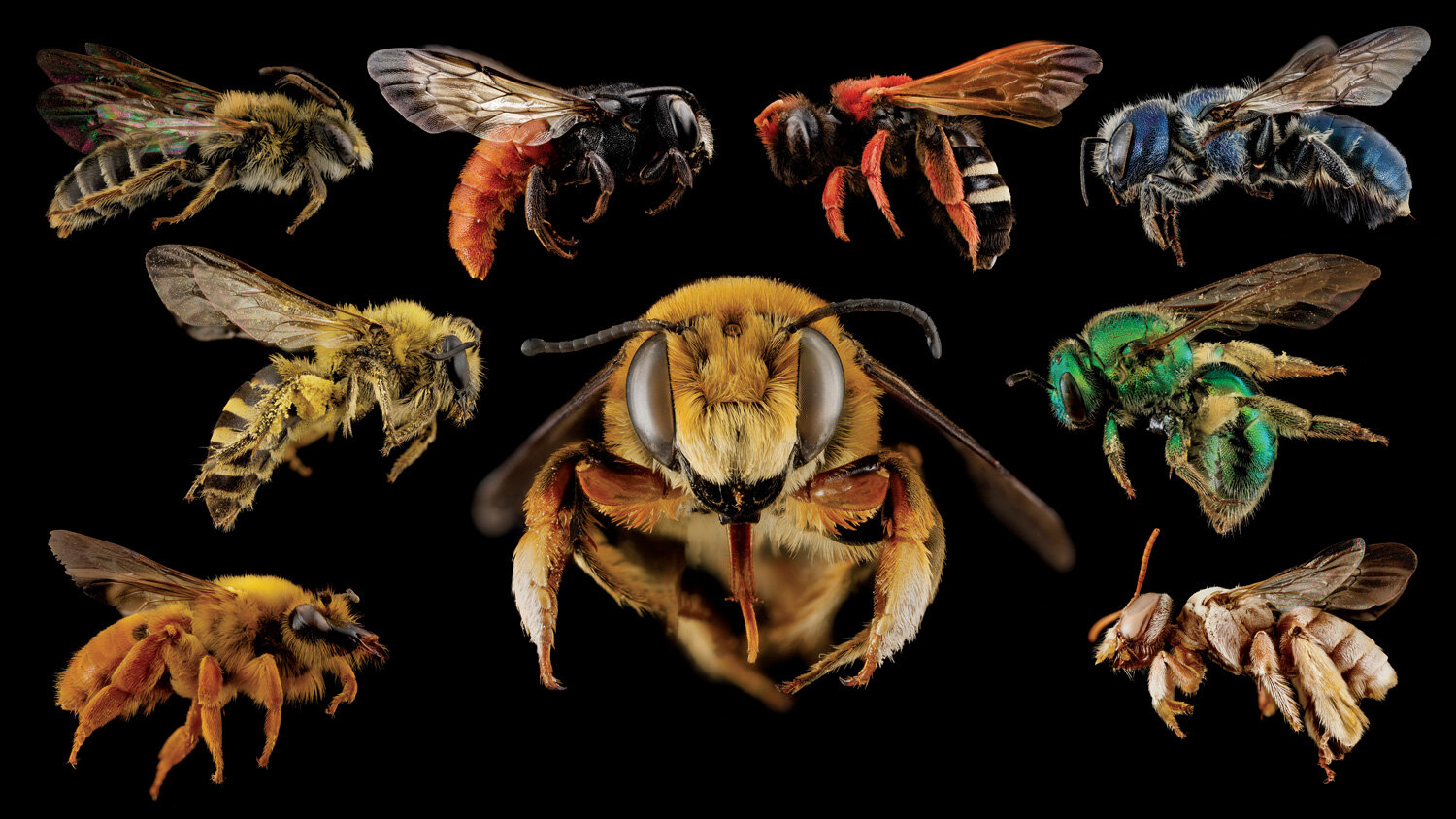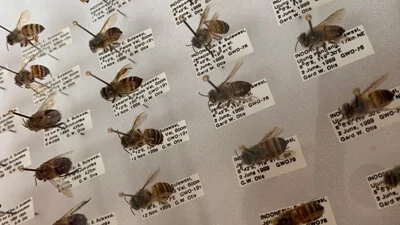Bee Diversity and Taxonomy
To understand bees today, we need to learn about their origins and how they’ve changed over time. Scientists uncover these mysteries by examining bee anatomy, behavior, genetic data, and by exploring the fossil record of ancient bee species. These insights help piece together the story of bees in the past and present. Learn more about entomologists and the research specimens that they study below.
There are seven families of bees. Each family has its own set of shared traits and a common evolutionary history. These seven families are further divided into 28 subfamilies. Each subfamily has a unique set of anatomical and biological features that makes it distinct and interesting. Only about half of the 28 subfamilies of bees occur in New York.
Family Melittidae
Melitta eickworti, a member of the bee family Melittidae. Image by Sam Droege (USGS Patuxent Wildlife Research Center; public domain).
Melittidae is the second-smallest bee family, with only 201 species. The earliest fossils of melittid bees date from the Eocene Epoch, approximately 53 million years ago. Melittid bees are solitary, build their nests in the ground, and have evolved to specialize on a small group of closely-related plants. They are most common in dry parts of southern Africa.
Example: Macropis nuda is an oil bee that collects oils exclusively from the flowering yellow loosestrife (Lysimachia) plants. These floral oils are mostly used to line cells intended for eggs and as a food source for larvae.
Family Apidae
Exaereta frontalis, a member of the bee family Apidae. Image by Sam Droege (USGS Patuxent Wildlife Research Center; public domain).
Apidae is the largest family of bees, with almost 6,000 species alive today. The family probably arose between 115 to 95 million years ago, and includes the oldest known fossil bee. The family Apidae includes the honey bee and 300 different types of bumblebee. Despite the importance of these bees in agriculture, the family Apidae also deserves attention for its diversity of solitary and social species.
Example: Amegilla dawsoni, “Dawson’s burrowing bee.” This bee is large, fast-flying, and solitary. Female burrowing bees build giant underground nests in their native Western Australia. Male burrowing bees can be large or small, which impacts their mating strategy.
Dawson’s burrowing bee (YouTube).
A ghost in the making: searching for the rusty-patched bumble bee (family Apidae) (Day’s Edge Productions; YouTube).
Family Megachilidae
Lithurgus tibialis, a member of the bee family Megachilidae. Image by Sam Droege (USGS Patuxent Wildlife Research Center; public domain).
Megachilidae is the third largest bee family, with over 4,000 species. Bees in this family occupy all continents except Antarctica, with habitats ranging from rainforests to deserts. They are amazingly diverse and resourceful. Megachilid bees use a variety of materials to construct their nests, including flower petals, mud, leaves, plant resin, soil, gravel, and even plastic shopping bags. They build their homes in walls, living plants, tree branches, empty insect nests, snail shells, stones, and termite nests.
Wallace’s giant bee, Megachile pluto.
One member of the Megachilidae is the largest bee on Earth: Wallace’s giant bee, Megachile pluto. Wallace’s giant bee was first encountered in 1859 by the co-discoverer of natural selection, Alfred Russel Wallace. Despite Megachile pluto’s unique size (females may reach a length of 1.5 inches with a wingspan of 2.5 inches), researchers only found it once more in 1981.
Scientists thought Wallace’s giant bee was extinct, lost forever … until 2019! After a mysterious new specimen appeared in an online auction, scientists rushed to the North Molucca islands in Indonesia. This bee lives in old treetop termite nests, making them difficult to find. After 5 days, researchers found a single Megachile pluto in the tropical forest. They took photos and videos, then released her.
“World’s largest bee rediscovered in Indonesia” by Guardian News (YouTube).
Megachile pluto isn’t extinct, but the species is still in danger. Deforestation and the market for poached specimens threatened this tiny population of “ridiculously large” bees.
Family Andrenidae
Andrena cragini, a member of the Family Andrenidae. Image by Sam Droege (USGS Patuxent Wildlife Research Center; public domain).
Andrenidae is a family with nearly 3,000 ground-nesting, solitary bee species. Many andrenid bees are adapted to harvest from a specific flowering plant. They live mostly in dry areas of western North America, South America, Europe, and Africa. Fossils of andrenid bees date back to the Oligocene Epoch, 32 million years ago.
Example: Andrena crataegi (see image above). Andrena crataegi emerges in the early spring. This bee pollinates fruit trees in the eastern United States. They’re especially good at pollinating apple trees. Thank the Andrena crataegi the next time you bite into a New York apple!
Family Halictidae
Augochloropsis anonyma, a member of the bee family Halictidae. Image by Sam Droege (USGS Patuxent Wildlife Research Center; public domain).
Halictidae is the second largest bee family, with almost 4,500 species. The family Halictidae is probably between 96 and 75 million years old. Fossils from this family are usually found in amber from the Baltic Region and the Dominican Republic.
Example: Rophites algirus. Halictid bees aren’t usually picky about their pollen sources. This bee species, however, only harvests from the hedgenettle Stachys plant. Rophites algirus has a special method of extracting hedgenettle pollen: the bee places her head in the flower, then vibrates her flight muscles. Once the bee’s face is covered in pollen, she transfers it to her hind legs and flies it back to the nest.
Family Stenotritidae
Ctenocolletes smaragdinus, a member of the bee family Stenotritidae. Image by Sam Droege (USGS Patuxent Wildlife Research Center; public domain).
There are only 21 species in the family Stenotritidae, making it the smallest of the seven bee families. Stenotritid bees are only found in Australia and have the most limited geographic range of any family. There are no known stenotritid fossils, but they likely split from the family Colletidae over 92 million years ago. Stenotritids are fast, large solitary bees that prefer an open and sandy habitat. Their ground nests can reach depths of 10 feet!
Example: Ctenocolletes nigricans. These bees are solitary ground nesters that have a preference for sandy habitats. This species has evolved to harvest from the dominant Australian plant family (Myrtaceae), including gum trees (Eucalyptus).
Family Colletidae
Caupolicana gaullei, a member of the bee family Colletidae. Image by Sam Droege (USGS Patuxent Wildlife Research Center; public domain).
There are 2,600 species in the family Colletidae, found mainly in Australia and South America. Almost all colletids are solitary. Colletids have a forked tongue, which is rare for modern bees. This tongue shape, although similar to their ancient wasp ancestors, evolved separately in this family to help these bees paint a cellophane-like lining inside their nests.
Example: Caupolicana yarrowi, “Yarrow’s fork-tongue.” Caupolicana yarrowi feeds its young with “bee beer” – a fermented brew of pollen, nectar, and yeast. To keep the “bee beer” contained, these bees line the walls of their brood cells with a material similar to cellophane. Larvae swim in the soupy mix, drinking their protein-rich “beer.”
Research on Bee Taxonomy
Entomology is the study of insects, including their relationships with other animals, their environments, and human beings. Entomological research can also give us broader insights into ecology, evolution, and social behavior. Entomologists study insects, such as ants, bees, and beetles. They also study arthropods, a related group of species that includes spiders and scorpions.
Specimens
Examples of mounted bee specimens.
Melittologists (entomologists who study bees) collect specimens for their research in a variety of ways. Some collecting techniques use passive traps that can be left in place for days or weeks. The most common way to collect bees is to net them on flowers with an aerial insect net. These specimens are then transferred to a small jar or vial with a killing agent, usually cyanide or ethyl acetate. Once the bees are dead, they can be mounted on pins, dried and labeled. Insect labels are tiny (and sometimes hard to read), but they include key information on where the specimen was collected (including country, state, distance to nearest town, and even latitude and longitude coordinates), when the specimen was collected (date), and who collected the specimen. Melittologists often include the host-plant on which the bee was collected as well. Complete and accurate specimen data is key to making insect specimens useful for scientific research.
Storage
Example of a Cornell drawer.
Some of the specimens displayed throughout the exhibit are in Cornell drawers. Entomologists throughout the United States use Cornell drawers to store pinned insects.
Contrary to their name, “Cornell drawers” weren’t invented at Cornell University! John Henry Comstock, Cornell professor and original manager of the school’s insect collection, first saw them at Harvard University’s Museum of Comparative Zoology. “Cornell drawers” were also used at Harvard and Germany’s Leipzig University before Comstock brought them to Cornell in the 19th century. The notoriety of Cornell’s entomology department made the drawers famous, coining the name.













